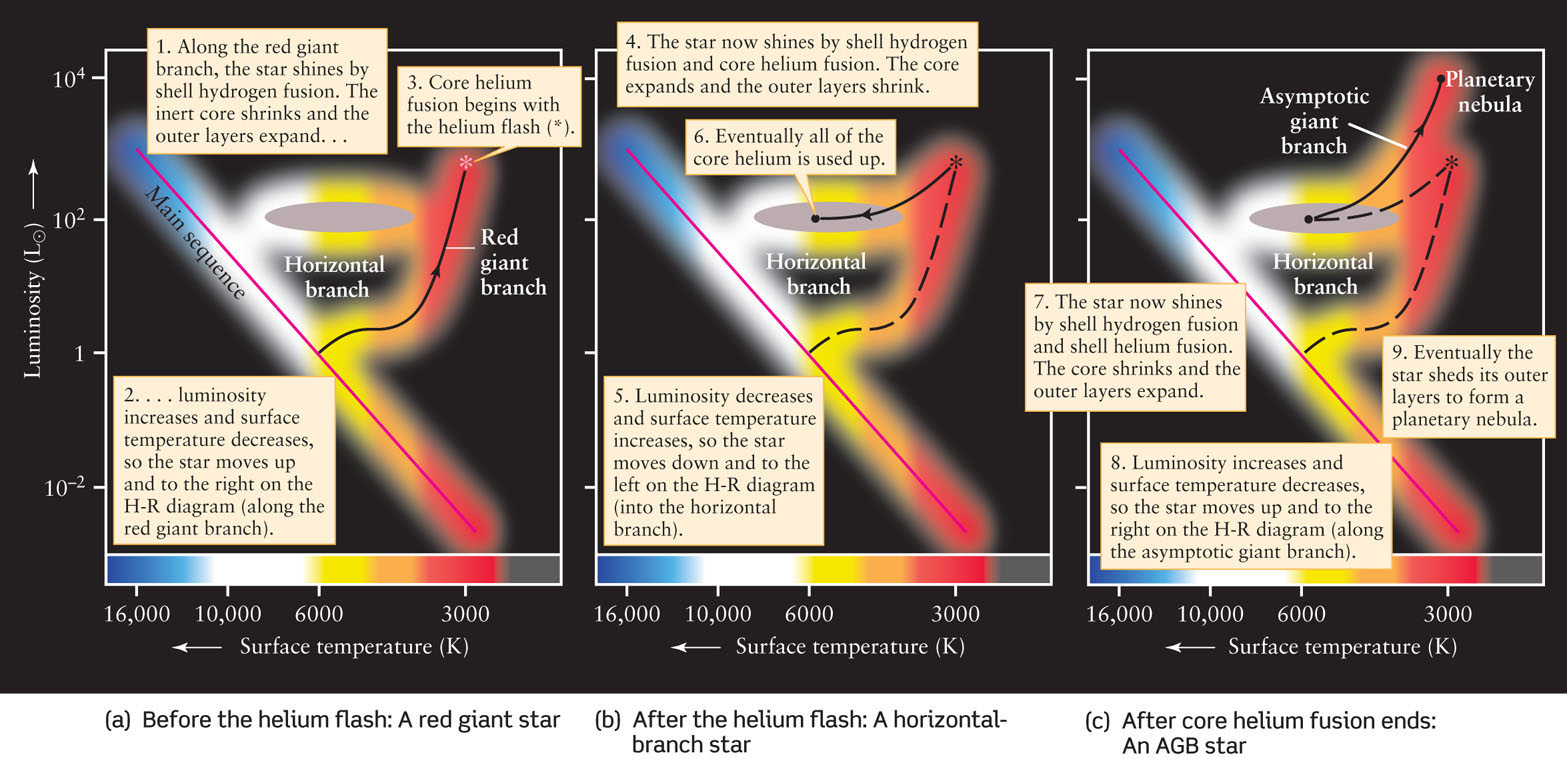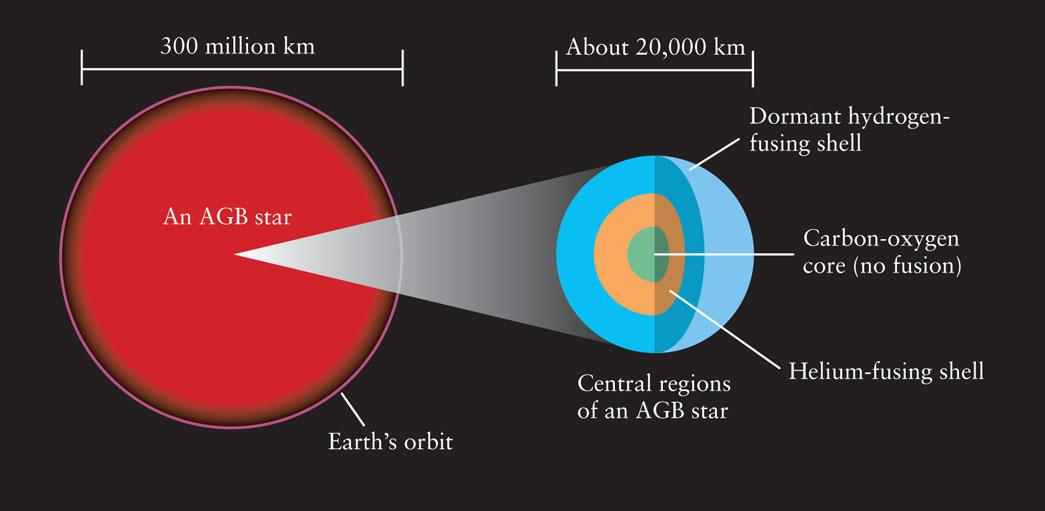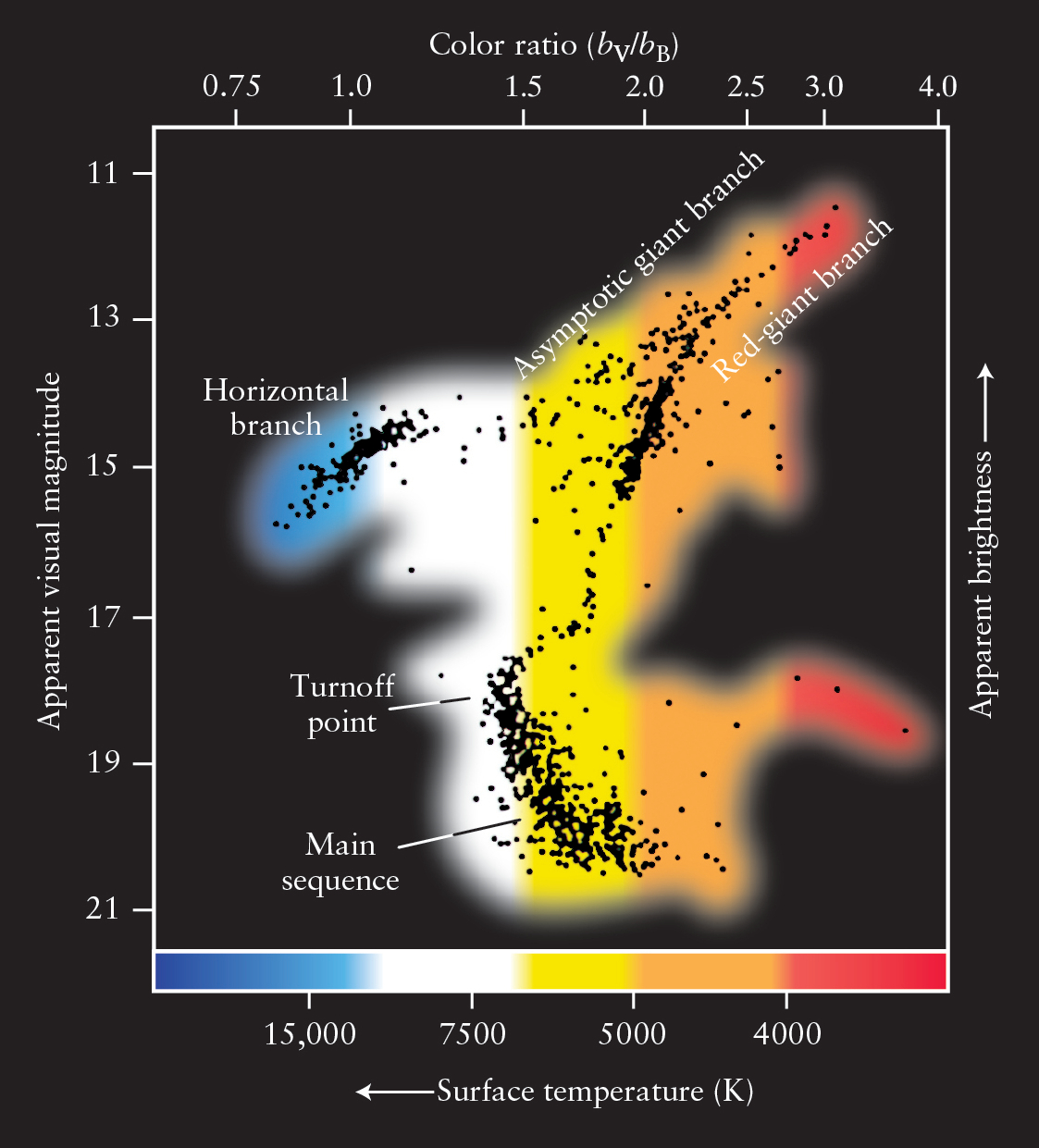20-1 Stars of between 0.4 and 4 solar masses go through two distinct red giant stages
 All main-sequence stars convert hydrogen to helium in their cores in a series of energy-releasing nuclear reactions. As we saw in Section 19-1, convection within a low-mass main-sequence star—a so-called red dwarf with a mass between 0.08 and 0.4 M⊙—will eventually bring all of the star’s hydrogen into the core. Thus, over hundreds of billions of years a red dwarf will end up as a ball of helium. Convection is less important in main-sequence stars with masses greater than 0.4 M⊙, so these stars are able to consume only the hydrogen that is present within the core. These stars of greater mass then leave the main sequence. Let’s examine what happens next for a star of moderately low mass, between 0.4 and 4 M⊙. One example for such a star is our own Sun, with a mass of 1 M⊙. We will begin by reviewing what we learned in Chapter 19 about the first stages of post–main-sequence evolution for such a star. (Later in this chapter, we will study the evolution of more massive stars.)
All main-sequence stars convert hydrogen to helium in their cores in a series of energy-releasing nuclear reactions. As we saw in Section 19-1, convection within a low-mass main-sequence star—a so-called red dwarf with a mass between 0.08 and 0.4 M⊙—will eventually bring all of the star’s hydrogen into the core. Thus, over hundreds of billions of years a red dwarf will end up as a ball of helium. Convection is less important in main-sequence stars with masses greater than 0.4 M⊙, so these stars are able to consume only the hydrogen that is present within the core. These stars of greater mass then leave the main sequence. Let’s examine what happens next for a star of moderately low mass, between 0.4 and 4 M⊙. One example for such a star is our own Sun, with a mass of 1 M⊙. We will begin by reviewing what we learned in Chapter 19 about the first stages of post–main-sequence evolution for such a star. (Later in this chapter, we will study the evolution of more massive stars.)
Note: Technically, the nuclear reactions referred to above are thermonuclear. The “thermo” in thermonuclear indicates that high-speed collisions, due to very high temperatures, help fuse atoms together despite electric repulsion between protons. In this chapter, we will often refer to these simply as nuclear reactions.
The Red Giant and Horizontal-Branch Stages: A Review
We can describe a star’s post–main-sequence evolution using an evolutionary track on a H-R diagram. Figure 20-1 shows the track for a 1-M⊙ star like the Sun. Once core hydrogen fusion ceases, the core shrinks, heating the nearby surrounding hydrogen and triggering shell hydrogen fusion (see Section 19-2). The new outpouring of energy causes the star’s outer layers to expand and cool, and the star becomes a red giant. As the luminosity increases and the surface temperature drops, the post–main-sequence star moves up and to the right along the red giant branch on an H-R diagram (Figure 20-1a).

 The Post–Main-Sequence Evolution of a 1-M⊙ Star These H-R diagrams show the evolutionary track of a star like the Sun as it goes through the stages of being (a) a red giant star, (b) a horizontal-branch star, and (c) an asymptotic giant branch (AGB) star. The star eventually evolves into a planetary nebula (described in Section 20-3).
The Post–Main-Sequence Evolution of a 1-M⊙ Star These H-R diagrams show the evolutionary track of a star like the Sun as it goes through the stages of being (a) a red giant star, (b) a horizontal-branch star, and (c) an asymptotic giant branch (AGB) star. The star eventually evolves into a planetary nebula (described in Section 20-3).
Next, the helium-rich core of the star shrinks and heats until eventually core helium fusion begins. This second post–main-sequence stage begins gradually in stars more massive than about 2–3 M⊙, but for less massive stars it comes suddenly—in a helium flash. During core helium fusion, the surrounding hydrogen-fusing shell still provides most of the red giant’s luminosity.
As we learned in Section 19-3, the core expands when core helium fusion begins, which makes the core cool down a bit. (We saw in Box 19-1 that letting a gas expand tends to lower its temperature, while compressing a gas tends to increase its temperature.) The cooling of the core also cools the surrounding hydrogen-fusing shell, so that the shell releases energy more slowly. Hence, the luminosity goes down a bit after core helium fusion begins.
The slower rate of energy release also lets the star’s outer layers contract. As they contract, they heat up, so the star’s surface temperature increases and its evolutionary track moves to the left on the H-R diagram in Figure 20-1b. The luminosity changes relatively little during this stage, so the evolutionary track moves almost horizontally, along a path called the horizontal branch. Horizontal-branch stars have helium-fusing cores surrounded by hydrogen-fusing shells. Figure 19-12 shows horizontal-branch stars in a globular cluster, and Figure 19-8 shows the evolution of the luminosity of a 1-M⊙ star up to this point in its history. (Technically, a star ceases to be a red giant as soon as it begins core helium fusion even though it is still red and giant for a while; we did not make this distinction in Chapter 19.)
CAUTION!
It is easy to get confused about the relationship between fusion inside and outside the core of a star versus the star’s overall size, temperature, and luminosity. Compared to fusion in the core, shell fusion releases energy at a greater rate. This increased energy puffs up the star’s outer layers. Shell fusion results in a larger star with a larger luminosity, even though its surface temperature decreases.
AGB Stars: The Second Red Giant Stage
Stars like the Sun go through a second red giant phase, during which helium fusion takes place in a shell around an inert core
Helium fusion produces nuclei of carbon and oxygen. After about a hundred million (108) years of core helium fusion, essentially all the helium in the core of a 1-M⊙ star has been converted into carbon and oxygen, and the fusion of helium in the core ceases. (This corresponds to the right-hand end of the graph in Figure 19-8.) Without nuclear reactions to maintain the core’s internal pressure, the core again contracts, until it is stopped by degenerate electron pressure (described in Section 19-3). This contraction releases heat into the surrounding helium-rich gases, and a new stage of helium fusion begins in a thin shell around the core. This process is called shell helium fusion.
History now repeats itself—the star enters a second red giant phase. A star first becomes a red giant at the end of its main-sequence lifetime, when the outpouring of energy from shell hydrogen fusion makes the star’s outer layers expand and cool. In the same way, the outpouring of energy from shell helium fusion causes the outer layers to expand again. The low-mass star ascends into the red giant region of the H-R diagram for a second time (Figure 20-1c), but now with even greater luminosity than during its first red giant phase.
Stars in this second red giant phase are commonly called asymptotic giant branch stars, or AGB stars, and their evolutionary tracks follow what is called the asymptotic giant branch. (Asymptotic means “approaching”; the name means that a star on the asymptotic giant branch approaches the red giant branch from the left on an H-R diagram.)
When a low-mass star first becomes an AGB star, it consists of a carbon-oxygen core (supported by degenerate electron pressure) with no nuclear reactions, and a helium-fusing shell, both inside a hydrogen-fusing shell, all within a volume not much larger than Earth. This small, dense central region is surrounded by an enormous hydrogen-rich envelope about as big as Earth’s orbit around the Sun. After a while, the expansion of the star’s outer layers causes the hydrogen-fusing shell to also expand and cool, and nuclear reactions in this shell temporarily cease. This leaves the aging star’s structure as shown in Figure 20-2.

We saw in Section 19-1 that the more massive a star, the shorter the amount of time it remains on the main sequence. Similarly, the greater the star’s mass, the more rapidly it goes through the stages of post–main-sequence evolution. Hence, we can see all of these stages by studying star clusters, which contain stars that are all the same age but that have a range of masses (see Section 19-4). Figure 20-3 shows a color-magnitude diagram for the globular cluster M55, which is at least 13 billion years old. The least massive stars in this cluster are still on the main sequence. Progressively more massive stars have evolved to the red giant branch, the horizontal branch, and the asymptotic giant branch.

A 1-M⊙ AGB star can reach a maximum luminosity of nearly 104 L⊙, as compared with approximately 103 L⊙ when it reached the helium flash and a relatively paltry 1 L⊙ during its main-sequence lifetime. When the Sun becomes an AGB star some 7.8 billion years from now, this tremendous increase in luminosity will cause Mars and the Jovian planets to largely evaporate away. The Sun’s bloated outer layers will reach to Earth’s orbit. Mercury and perhaps Venus will simply be swallowed whole.
CONCEPT CHECK 20-1
Why does helium fusion in a star’s core, which releases energy, actually lead to a decrease in its luminosity? What are these stars called on the H-R diagram?
The energy released from core helium fusion expands the star’s core, and this slows down reactions for both the core helium fusion and the hydrogen-fusing shell. With a decreased rate of energy released in and around the star’s core, the luminosity of the star decreases. These stars are called horizontal-branch stars.